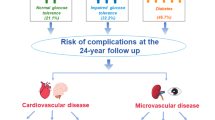Abstract
Introduction
This study investigated the outcomes and identified influencing factors of intensive integrated intervention over 2 years in Chinese patients with impaired glucose regulation (IGR).
Methods
Adults in Beijing, China, were screened for IGR using the 75 g oral glucose tolerance test. Participants with IGR received lifestyle and health education; those who still had IGR after 1 year were randomly assigned to either a routine care group or to an intensive integrated intervention group.
Results
Of 2344 adults screened, 463 had IGR. Of these, 210 adults had IGR after 1 year and were therefore recruited and randomized to an intensive integrated intervention group (n=106) or a control group (n=104). The percentage of patients who reached the set targets of plasma glucose, blood pressure, body mass index, or triglycerides was significantly higher in the intensive integrated intervention group. None of the patients within the intensive integrated intervention group progressed to diabetes, whereas eight (9.3%) cases of the control group developed type 2 diabetes mellitus (T2DM). Logistic regression analysis showed that both an increase in waist circumference and systolic blood pressure (SBP) were positively correlated with the development of T2DM, whereas improvement in islet beta cell function was negatively correlated with the development of T2DM.
Conclusions
Intensive integrated intervention may significantly decrease the conversion rate of IGR to T2DM, and increase the conversion ratio to normal glucose tolerance. The increase of waist circumference or SBP and the deterioration of islet beta cell function may be important risk factors for progression from prediabetes to diabetes.
Similar content being viewed by others

References
Wild S, Sicree R, Roglic G, King H, Green A. Global prevalence of diabetes. Estimates for the year 2000 and projections for 2030. Diabetes Care. 2004;27:1047–1053.
Yang WY, Lu JM, Weng JP, et al. Prevalence of diabetes among men and women in China. N Engl J Med. 2010;362:1090–1101.
Harris MI. Impaired glucose tolerance: prevalence and conversion to NIDDM. Diabetic Med. 1996;13(Suppl 2):S9–S11.
The DECODE Study Group. Glucose tolerance and cardiovascular mortality. Comparison of fasting and 2-hour diagnostic criteria. Arch Intern Med. 2001;161:397–404.
Tominaga M, Eguchi H, Manaka H, Igarashi K, Kato T, Sekikawa A. Impaired glucose tolerance is a risk factor for cardiovascular disease, but not impaired fasting glucose. Diabetes Care. 1999;22:920–924.
Zimme PZ. The pathogenesis and prevention of diabetes in adults. Genes, autoimmunity and demography. Diabetes Care. 1995;18:1050–1064.
Expert Committee on the Diagnosis and Classification of Diabetes Mellitus. Follow-up report on the diagnosis of diabetes mellitus. Diabetes Care. 2003;26:3160–3167.
Matthews DR, Hosker JP, Rudenski AS, Naylor BA, Treacher DF, Turner RC. Homeostasis model assessment: insulin resistance and β cell function from fasting plasma glucose and insulin concentrations in man. Diabetologia. 1985;28:412–419.
Pan XR, Li GW, Hu YH, et al. Effects of diet and exercise in preventing NIDDM in people with impaired glucose tolerance. The Da Qing IGT and Diabetes Study. Diabetes Care. 1997;20:537–544.
Knowler WC, Barrett-Connor E, Fowler SE, et al. Diabetes prevention program research group reduction in the incidence of type 2 diabetes with lifestyle intervention or metformin. N Engl J Med. 2002;346:393–403.
Lindstrom J, Louheranta A, Mannelin M, Rastas M, Salminen V, Eriksson J. The Finnish Diabetes Prevention Study (DPS): lifestyle intervention and 3-year results on diet and physical activity. Diabetes Care. 2003;26:3230–3236.
Mensink M, Feskens EJM, Saris WHM, Debruin TWA, Blaak EE. Study on lifestyle intervention and impaired glucose tolerance Maastricht (SLIM): preliminary results after one year. Int J Obes Relat Metab Disord. 2003;27:377–384.
Chiasson JL, Josse RG, Gomis R, Hanefeld M, Karasik A, Laakso M. STOP-NIDDM Trail Research Group. Acarbose for prevention of type 2 diabetes mellitus: the STOP-NIDDM randomised trial. Lancet. 2002;359:2072–2077.
Chiasson JL, Josse RG, Gomis R, Hanefeld M, Karasik A, Laakso M. STOP-NIDDM Trial Research Group. Acarbose treatment and the risk of cardiovascular disease and hypertension in patients with impaired glucose tolerance: the STOP-NIDDM trial. JAMA. 2003;290:486–494.
Li CL, Pan CY, Lu JM, et al. Effect of metformin on patients with impaired glucose tolerance. Diabet Med. 1999;16:477–481.
Yang WY, Lin LX, Qi JW, et al. The preventive effect of Acarbose and Metformin on the IGT population from becoming diabetes mellitus: a 3-year multicentral prospective study. Chin J Endocrinol Metab. 2001;17:131–134.
Kawamori R, Tajima N, Iwamoto Y, Kashiwagi A, Shimamoto K, Kaku K. Voglibose for the prevention of type 2 diabetes mellitus: a randomised, double-blind trial in Japanese subjects with impaired glucose tolerance. Nippon Rinsho. 2010;68:873–881.
Azen SP, Peters RK, Berkowitz K, Kjos S, Xiang A, Buchanan TA. TRIPOD (Troglitazone In the Prevention Of Diabetes): a randomized, placebo-controlled trial of troglitazone in women with prior gestational diabetes mellitus. Control Clin Trials. 1998;19:217–231.
The DREAM (Diabetes Reduction Assessment with ramipril and rosiglitazone Medication) Trial Investigators. Effect of rosiglitazone on the frequency of diabetes in patients with impaired glucose tolerance or impaired fasting glucose: a randomized controlled trial. Lancet. 2006;368:1096–1105.
Weyer C, Bogardus C, Pratley RE. Metabolic characteristics of individuals with impaired fasting glucose and/or impaired glucose tolerance. Diabetes. 1999;48:2197–2203.
Abdul-Ghani MA, Jenkinson CP, Richardson DK, Tripathy D, Defronzo RA. Insulin secretion and action in subjects with impaired fasting glucose and impaired glucose tolerance: results from the Veterans Administration Genetic Epidemiology Study. Diabetes. 2006;55:1430–1435.
DeFronzo RA, Banerji MA, Bray GA, et al. Determinants of glucose tolerance in impaired glucose tolerance at baseline in the Actos Now for Prevention of Diabetes (ACT NOW) study. Diabetologia. 2010;53:435–445.
Author information
Authors and Affiliations
Corresponding author
Rights and permissions
About this article
Cite this article
Lu, YH., Lu, JM., Wang, SY. et al. Outcome of intensive integrated intervention in participants with impaired glucose regulation in China. Adv Therapy 28, 511–519 (2011). https://doi.org/10.1007/s12325-011-0022-4
Received:
Published:
Issue Date:
DOI: https://doi.org/10.1007/s12325-011-0022-4


